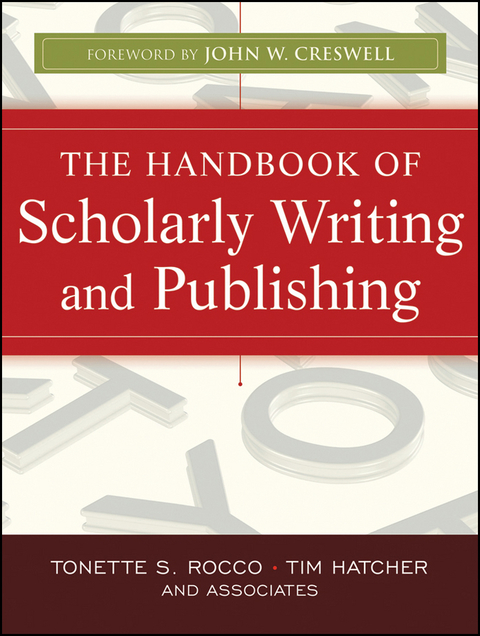Description
Efnisyfirlit
- Cover
- Title
- Copyright
- Series
- Dedication
- Foreword
- Preface
- Content Overview
- Audience
- ABOUT THE EDITORS
- ABOUT THE AUTHORS
- PART ONE: BECOMING A PUBLISHED SCHOLAR
- CHAPTER 1: REASONS TO WRITE, WRITING OPPORTUNITIES, AND OTHER CONSIDERATIONS
- Reasons to Write
- Creating Writing Opportunities
- Learning to Write
- Writing Tips
- Concluding Remarks
- References
- CHAPTER 2: PUBLISHING IN PEER-REVIEWED AND NONREFEREED JOURNALS
- Searching for and Selecting Topics
- Writing and Revising the Manuscript
- Mechanics of Manuscript Preparation
- Deciding Where to Submit the Manuscript
- Working with Editors
- Seeking Feedback: Pro and Con
- Building Momentum: Multiple Publications from a Single Idea
- Summary and Conclusion
- References
- CHAPTER 3: LEARNING TO WRITE
- Our Scholarly Writing Experiences
- Appreciating the Importance of Scholarly Writing
- Getting Started
- Building Relationships
- Building Writing Skills
- Taking the Plunge
- References
- CHAPTER 4: SCHOLARLY READING AS A MODEL FOR SCHOLARLY WRITING
- Integrating Reading and Writing
- Being Constructively Critical as a Reader and Self-Critical as a Writer
- Getting into an Argument
- Warranting the Degree of Certainty and Generalization of Claims
- Writing for Critical Readers
- Conclusion
- References
- CHAPTER 5: WORKING WITH TENSIONS
- The Changing Doctorate
- Stories of Tensions for Doctoral Students
- Conclusion: Working with the Tensions
- References
- CHAPTER 6: THE PROCESS OF TRANSFORMING THE DISSERTATION OR THESIS INTO PUBLICATION
- Rationale for Publishing the Dissertation
- The Publishing Process
- Making Writing a Regular Work Habit
- Pruning, Paring Down, and Prioritizing the Dissertation Content
- Final Reflections
- References
- PART TWO: IMPROVING WRITING TECHNIQUES
- CHAPTER 7: WRITING WITH AUTHORITY
- Pitfalls
- Pit Stops
- Conclusion
- References
- CHAPTER 8: FINDING VOICE
- Authenticity
- Academic Voice
- Authorial Reflections
- Tools of the Trade: A Tool Kit
- References
- CHAPTER 9: CREATING A WHOLE FROM THE PARTS
- Communicating the Compelling Problem
- The Literature Review
- The Role of a Theoretical or Conceptual Framework
- The Method Section
- Discussion of Findings
- Conclusions and Implications for Practice and Future Research
- Summary
- References
- CHAPTER 10: DEVELOPING A RESEARCH PROBLEM AND PURPOSE STATEMENT
- Role of the Research Problem
- Deriving Problem Statements
- Constructing Problem Statements
- Implications of the Problem Statement
- Conclusion
- References
- PART THREE: PREPARING SCHOLARLY MANUSCRIPTS
- CHAPTER 11: WRITING A LITERATURE REVIEW
- Defining Literature Reviews
- Preliminary Work: Building the Foundation
- Scholarly Analysis of Selected Sources
- Writing the Review
- Conclusion
- References
- CHAPTER 12: INCREASING THE ODDS OF PUBLISHING A QUALITATIVE MANUSCRIPT
- Introduction
- Method
- Discussion
- Implications
- Concluding Thoughts
- References
- CHAPTER 13: INCREASING THE LIKELIHOOD OF PUBLISHING QUANTITATIVE MANUSCRIPTS
- Framing Your Article for Review
- Research Method
- Presenting and Interpreting Findings
- Ethical Standards in Collecting and Reporting Data
- Conclusion
- References
- CHAPTER 14: WRITING RESEARCH ARTICLES USING MIXED METHODS
- Purpose of This Chapter
- Philosophical Assumptions Underlying Research Methodologies
- Typology of Purpose
- Mixed Method Designs
- Legitimation Techniques
- Conclusion
- References
- Notes
- CHAPTER 15: WRITING THEORY, CONCEPTUAL, AND POSITION ARTICLES FOR PUBLICATION
- Theory Articles
- Conceptual Articles
- Opinion Articles
- Submission Outlets
- Conclusion
- References
- CHAPTER 16: CREATING AND PUBLISHING NONREFEREED MANUSCRIPTS
- Guidance for Writing Nonrefereed Manuscripts
- Ethical Issues in Nonrefereed Publications
- Writing the Editorial
- Writing the Book Review
- Summary and Conclusions
- References
- PART FOUR: REFLECTING ON THE WRITING AND PUBLISHING PROCESS
- CHAPTER 17: WHY WRITERS SHOULD ALSO BE REVIEWERS
- Lesson 1: The Need to Decenter
- Lesson 2: The Logic of Certain Grammar Rules
- Lesson 3: Providing Feedback in Ways That Help Rather Than Hurt
- Lesson 4: Learning Through Positive Models
- Lesson 5: An Opportunity to Compare One’s Critiques with the Critiques of Others
- So, How Does a Scholar New to His or Her Field Become a Reviewer?
- Conclusion
- References
- CHAPTER 18: ADDRESSING FEEDBACK FROM REVIEWERS AND EDITORS
- The Emotional Cycle of Responding to Feedback
- Understanding the Reasons for Negative Feedback
- Responding Technically to Feedback
- Addressing Specific Suggestions
- When Not to Proceed
- Conclusion
- References
- CHAPTER 19: INTERNATIONAL AND CROSS-CULTURAL ISSUES IN SCHOLARLY PUBLISHING
- Identification of Research Topics
- Research Design and Methodological Issues
- Writing in a Different Language
- Ethical Issues
- Conclusions
- References
- CHAPTER 20: WORKING WITH COAUTHORS
- A Tale of Three Scholars: Beginning a Coauthoring Journey
- Empirical and Theoretical Framework for Collaborative Writing
- Dimensions of the Collaborative Teaming Process
- Discussion
- References
- CHAPTER 21: WRITING AS MENTORING
- Definition of Mentoring
- Benefits of Mentoring: Mentors and Mentees
- Forming a Mentoring Relationship
- Elements of Successful Mentoring Relationships
- Future Trends
- References
- RESOURCES: FURTHER READING FOR SCHOLARLY WRITING
- INDEX
- End User License Agreement






Reviews
There are no reviews yet.